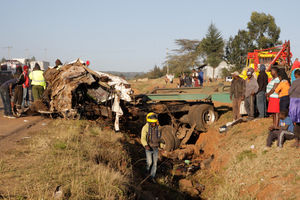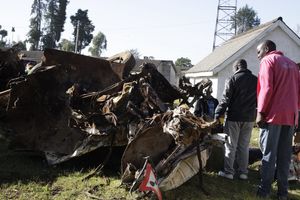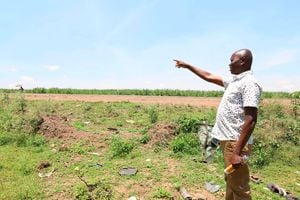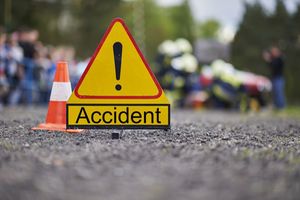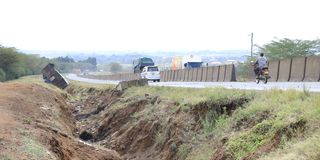
The scene of the March 14, 2025 accident that killed 14 people in Migaa on the Nakuru-Eldoret highway.
In April 2018, the Kenya National Highways Authority (KeNHA) awarded a contract to China Railway Number 10 Company to construct a 21-kilometre concrete barrier on the notorious Nakuru-Eldoret highway.
The Sh500 million concrete barrier, which stretches from Salgaa trading centre to Sachang'wan, was seen as a crucial step in curbing the frequent and deadly accidents that had earned the stretch the title of "killer stretch".
The project was welcomed by motorists, locals and police who had witnessed hundreds of horrific road accidents along the stretch.
Many saw the barrier as a life-saving solution, designed to separate lanes and prevent head-on collisions, which were a major cause of fatalities.
Since its completion in 2018, the so-called 'magic wall' has indeed prevented many head-on collisions, drastically reducing the number of accidents and improving safety for the thousands of motorists who use the road every day.

A section of the 11km Sachang'wan stretch on the Nakuru-Eldoret highway.
Traffic police records show that in 2017, a total of 50 accidents were reported in the Salgaa-Total area, involving 284 people. Of these, 138 people lost their lives.
After the construction of the barrier, the number of accidents decreased significantly.
In 2018, the number of accidents fell to 23, with 22 fatalities, and in 2019, from January to October, a total of 19 accidents were recorded, with 16 fatalities.
However, five years after its construction, the stretch continues to claim lives despite the barrier, raising questions: Has this once-promising safety measure failed? Why does the 'killer stretch' continue to live up to its name despite significant investment?
The number of accidents, injuries and deaths along this stretch of motorway remains alarmingly high.
While the barrier has helped in some ways, it has not provided the comprehensive solution that many had hoped for.
In just 10 months, at least 33 people have lost their lives and scores more have been injured in a series of crashes at the notorious Migaa black spot, despite the presence of the concrete wall.
One of the most recent incidents took place at 2am on March 14 when at least 14 people, including a child, were killed in a gruesome accident.
The accident occurred when the driver of a truck carrying sacks of coffee for export lost control of his vehicle. The truck veered off the road before hitting an 11-seater Nairobi-bound Kitale shuttle bus.
Both vehicles were travelling in the same direction from Eldoret to Nakuru when the tragedy occurred.
Just eight months before last week's crash, 14 people were killed and dozens injured in another early morning accident at the same spot.
In August 2024, a Coast Bus crashed into several vehicles, before rolling into a ditch. The ill-fated bus was carrying passengers from Kisumu to Mombasa when its brakes failed. It rammed into barriers and other vehicles before overturning in a ditch. Thirteen people died on the spot, while another succumbed to his injuries while receiving treatment at Nakuru Teaching and Referral Hospital.
Investigations later revealed that the long-distance bus had been experiencing mechanical problems prior to the crash -- problems that the driver and conductor allegedly ignored.
On May 25, 2024, five people lost their lives at the Migaa black spot after the vehicle they were travelling in rammed into a trailer.
The accident, which occurred at 3am, involved a vehicle travelling from Eldoret to Nakuru. On reaching Migaa, the vehicle rammed into the back of a trailer.
The matatu had been hired by church members travelling to Mbooni, Machakos County, for a funeral. The 15 passengers had set off shortly after midnight.
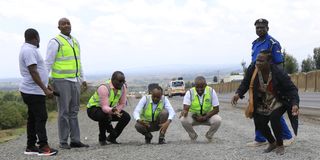
Kenya National Highways Authority staff inspect the runaway lane at Migaa on the Nakuru-Eldoret highway.
As accidents at the black spot become alarmingly common, the National Transport and Safety Authority (NTSA) and the Kenya National Highways Authority (KeNHA) have come under increasing criticism for failing to curb the carnage.
Kevin Ngetich, a resident of Sachang'wan, believes the stretch has become notorious due to a number of factors, including poor road signage, reckless driving, speeding and overtaking.
He also pointed out that potholes on the road have increased the risk of accidents, as drivers swerve dangerously to avoid them. In addition, a ditch near the highway has continued to deepen as the rain has continued, making the situation worse.
While the concrete barrier has helped prevent head-on collisions, Ngetich argues that it has also created a false sense of security among some drivers.
“Many motorists, feeling protected by the barrier, have become more daring and aggressive in their driving. They overtake and speed without considering the actual road conditions,” he said.
“We were happy when the barrier was erected. Accidents reduced, but we are now back to those days where we hardly sleep. We have lost many lives at this spot. KeNHA should act fast. There’s a ditch forming near the highway, and when vehicles lose control, they plunge into it, making the situation worse.”
Another resident, Komen Kibet, said that many lorry drivers freewheel along the stretch, making it difficult to regain control if something goes wrong. He also pointed out the lack of proper road markings and signage.
Given that the Nakuru-Eldoret Highway is one of the busiest roads in Kenya, with heavy traffic in both directions, Kibet stressed the need for immediate action.
“While the physical barrier might offer some protection, it is only part of the solution. Effective enforcement of traffic laws is just as important. KENHA should erect black spot warning signs to alert night-time travellers,” he said.
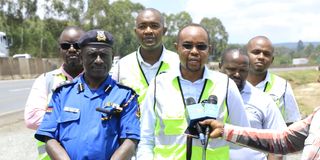
Kenya National Highways Authority Corridor B director Eng. Kibet Tergin speaks to journalists at Migaa on the Nakuru-Eldoret highway.
But according to KeNHA Corridor B Director Engineer Kibet Tergin, studies show that the Migaa section experiences a high number of accidents due to brake failure.
In response, a 500-metre runaway truck ramp has been constructed at Migaa to safely stop trucks that lose control regardless, whether they are loaded or empty.
“This is a new infrastructure on our road network and we have already seen its effectiveness. Several accidents have been prevented and truck drivers can attest to its success,” said Eng Kibet on Tuesday.
To improve road safety, KeNHA has also installed signage along this dangerous black spot and other accident-prone areas to warn drivers, especially those unfamiliar with the terrain.
However, the official expressed concern about vandalism, saying that some road signs have been stolen.
Another challenge is the theft of materials used in constructing the runaway truck ramp, which alters its design and compromises its effectiveness.
Addressing concerns about rainwater drainage along the road, Mr Kibet clarified that standard road designs require side drains. However, KeNHA is reviewing the drainage system to make it more “forgiving” in case a vehicle loses control.
A “forgiving drainage” system refers to a road drainage design that minimises the risk of serious accidents if a vehicle veers off the road.
In this context, KeNHA aims to modify the side drains so that if a vehicle loses control and leaves the roadway, the drainage features (such as ditches or culverts) will not worsen the situation by causing a vehicle to overturn, crash violently, or get stuck.
“There has been a lot of discussion about the storm water drainage in the road. We want to confirm that a standard design for a road requires a side drain to be there. What have been picked out from previous incidents is that we need to make our drainage forgiving, what we are doing as KeNHA is that we are analysing the side drains so that if there is opportunity, we will improve them and make them forgiving in case a vehicle loses control,” he said.

